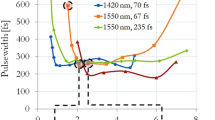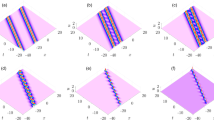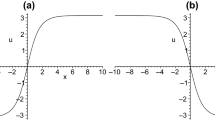Abstract
Following an analytically predicted energy diagram, we numerically investigate the behavior of a soliton molecule in terms of its energy with respect to the breathing factor and average-dispersion of dispersion managed optical fiber lines. We demonstrate the stable families of soliton molecules in anomalous, normal and zero average dispersion regimes. For normal average dispersion, it is showed that each stable family of SM is distributed over a lower and an upper branches. Further, the stability range is limited by a threshold value and a higher value of the breathing factor.














Similar content being viewed by others
References
Agrawal, G.P.: Fiber-Optics Communication Systems, 4th edn. Wiley-Interscience, New York (2010)
Alamoudi, S.M., Al Khawaja, U., Baizakov, B.B.: Averaged dynamics of soliton molecules in dispersion-managed optical fibers. Phys. Rev. A 89, 1–9 (2014)
Feng, B.F., Malomed, B.A.: Antisymmetric solitons and their interactions in strongly dispersion-managed fiber-optic systems. Opt. Commun. 229, 173–185 (2004)
Gabitov, I., Indik, R., Mollenauer, L., Shkarayev, M., Stepanov, M.: Twin families of bisolitons in dispersion-managed systems. Opt. Lett. 32, 605–607 (2007)
Gholami, S., Rohrmann, Ph, Hause, A., Mitschke, F.: Optimization strategy to find shapes of soliton molecules. Appl. Phys. B. 116, 43–52 (2014)
Gordon, J.P.: Interaction forces among solitons in optical fibers. Opt. Lett. 8, 596–598 (1983)
Grelu, Ph., Belhache, F., Gutty, F., Soto-Crespo, J.M.: Soliton pairs in a fibre laser: from anomalous to normal average dispersion regime. Opt. Lett. 27, 966–968 (2002)
Hause, A., Mitschke, F.: Higher-order equilibria of temporal soliton molecules in dispersion-managed fibers. Phys. Rev. A 88, 1–10 (2013)
Hause, A., Hartwig, H., Seifert, B., Stolz, H., Böhm, M., Mitschke, F.: Phase structure of solton molecules. Phys. Rev. A 75, 1–7 (2007)
Hause, A., Hartwig, H., Böhm, M., Mitschke, F.: Binding mechanism of temporal soliton molecules. Phys. Rev. A 78, 1–9 (2008)
Krupa, K., Nithyanandan, K., Andral, U., Dinda, P., Grelu, Ph.: Real-time observation of internal motion within ultrafast dissipative optical soliton molecules. Phys. Rev. Lett. 118, 1–5 (2017)
Lakoba, T.I., Yang, J., Kaup, D.J., Malomed, B.A.: Antisymmetric solitons and their interactions in strongly dispersion-managed fiber-optic systems. Opt. Commun. 149, 366–375 (1998)
Malomed, B.A.: Bound solitons in the nonlinear Schrödinger–Ginzburg–Landau equation. Phys. Rev. A 44, 6954–6957 (1991)
Mitschke, F.M., Mollenauer, L.F.: Experimental observation of interaction forces between solitons in optical fibers. Opt. Lett. 12, 355–357 (1983)
Moubissi, A.-B., Nse Biyoghé, S., Mback, C.B.L., Ekogo, T. B., Ben-Bolie, G.H., Kofané, T.C., Tchofo Dinda, P.: Analytical design of soliton molecules in fibers. J. Opt. 18, 1–6 (2016)
Moubissi, A.-B., Tchofo Dinda, P., Nse Biyoghé, S.: Highly stable families of soliton molecules in fiber-optic systems. J.Opt. 20, 1–9 (2018)
Moubissi, A.-B., Ekogo, Th.B., Bidouba Sanvany, D.S., Moussambi Membetsi, Z.H., Dikandé, A.M.: Averaged-dispersion management for ultrashort soliton molecule propagation in lossy fibre systems. Opt. Commun. 431, 187–195 (2019). https://doi.org/10.1016/j.optcom.2018.09.030
Nakkeeran, K., Moubissi, A.B., Tchofo Dinda, P., Wabnitz, S.: Analytical method for designing dispersion-managed fiber systems. Opt. Lett. 20, 1544–1546 (2001)
Nakkeeran, K., Moubissi, A.B., Tchofo Dinda, P.: Analytical design of dispersion-managed fiber system with map strength 1.65. Phys. Lett. A 308(5–6), 417–425 (2003)
Nijhof, J.H.B., Forysiak, W., Doran, N.J.: The averaging method for finding exactly periodic dispersion-managed solitons. IEEE J. Sel Top. Quantum Electron. 6, 330–336 (2000)
Nse Biyoghé, S., Ekogo, Th.B., Moubissi, A.-B.: Collective variable analysis of the nonlinear Schrödinger equation for soliton molecules in fibers. J. Nonlinear Opt. Phys. Mater. 26, 1–13 (2017)
Paré, C., Bélanger, P.-A.: Antisymmetric soliton in a dispersion-managed system. Opt. Commun. 168, 103–109 (1999)
Rohrmann, P., Hause, A., Mitschke, F.: Solitons beyond binary: possibility of fibre-optic transmission of two bits per clock period. Sci. Rep. 2, 1–4 (2012)
Rohrmann, P., Hause, A., Mitschke, F.: Two-soliton and three-soliton molecules in optical fibers. Phys. Rev. A 87, 1–10 (2013)
Sakaguchi, H., Skryabin, D.V., Malomed, B.A.: Stationary and oscillatory bound states of dissipative solitons created by third-order dispersion. Opt. Lett. 43, 2688–2690 (2018)
Shkarayev, M., Stepanov, M.G.: New bisoliton solutions in dispersion managed systems. Physica D 238, 840–845 (2009)
Smith, N.J., Knox, F.M., Doran, N.J., Blow, K.J., Bennion, I.: Enhanced power solitons in optical fibers with periodic dispersion management. Electron. Lett. 32, 54–55 (1996)
Stratmann, M., Pagel, T., Mitschke, F.: Experimental observation of temporal soliton molecules. Phys. Rev. Lett. 95, 1–4 (2005)
Tang, D.Y., Man, W.S., Tam, H.Y., Drummond, P.D.: Observation of bound states of solitons in passively mode-locked fiber laser. Phys. Rev. A 64, 1–3 (2001)
Tchofo Dinda, P., Moubissi, A.B., Nakkeeran, K.: Collective variable theory for optical solitons in fibers. Phys. Rev. E 64, 1–15 (2001)
Turitsyn, S.K., Bale, B.G., Fedoruk, M.P.: Dispersion-managed solitons in fibre systems and lasers. Phys. Rep. 521, 1–69 (2012)
Zakharov, V.E., Wabnitz, S.: Optical Solitons: Theoretical Challenges and Industrial Perspectives. Springer, New York (1998)
Author information
Authors and Affiliations
Corresponding author
Appendix: Analytical design of SMs in fibers
Appendix: Analytical design of SMs in fibers
Here, it is worth re-emphasizing that a SM is an entity which is not only able to move as a whole entity, but can also execute internal vibrations similar to those of a matter molecule. Its internal dynamic is rather similar to that of a mechanical system made up of several components interacting in a rather elastic manner. Each component of the molecule may be considered as a light pulse, but whose internal dynamic is not necessarily the same as that of the other components of the molecule, since optical fiber is an environment which is always more or less prone to various perturbations. Nevertheless, it is possible to obtain an overview of the overall dynamics of the molecule, including its internal dynamics, by means of a relatively small number of dynamical variables, called collective coordinates, provided that these coordinates are appropriately chosen to describe all the major degrees of freedom of the internal dynamics of the molecule. The collective coordinates are introduced in the theoretical treatment of the dynamics of a solitonic entity by means of an ansatz function, which can be chosen to be of the following form:
where \(\xi = (t-x_2)/x_3\), and the function \(\phi\) is as yet an unknown function, which will be chosen to represent at best the exact profile of the solitonic entity. Here, the coordinates \(x_{2}, x_{4}, x_{5}\) and \(x_{6}\), represent respectively the position of the center-of-mass, the chirp, the frequency, and the phase constant of the soliton molecule as a whole entity. The ansatz defined by (1) can be used to represent both a conventional DM soliton and a soliton molecule. In particular, the function \(\phi\) and the coordinates \(x_1\) and \(x_3\), are used to structure the intensity profile of the desired type of soliton. Hence, the analytical expression of \(\phi\) and the physical meaning of \(x_1\) and \(x_3\), differ depending on the type of solitonic entity considered.
\(\bullet\) For a conventional DM soliton, the function \(\phi\) can be chosen as follows (Zakharov and Wabnitz 1998):
and in this case, the coordinates \(x_1\) and \(x_3\) represent the amplitude and pulse width, respectively.
\(\bullet\) For a two-SM, the function \(\phi\) may be chosen to be (Alamoudi et al. 2014; Moubissi et al. 2016):
and here, \(x_1=a\sqrt{2e}\), a being the amplitude of the molecule, and \(x_3 = d/\sqrt{2}\), d representing the temporal separation between the two pulses that make up the molecule(Moubissi et al. 2016).
By inserting the ansatz (1) in Eq. (1), and applying the collective variable method on the resulting equation (Dinda et al. 2001), we obtain the following set of ordinary differential equations, which describe the spatial evolution of the collective coordinates:
Here, \(\alpha _1 = 4\, (4)\), \(\alpha _2 = \sqrt{2} \, (\sqrt{2}/16)\), \(\alpha _3 = 1 \, (3)\) and \(\alpha _4 = 5/4\sqrt{2} \, (15/128)\) for the single soliton (two-SM). It is possible to integrate the above set of equations so as to obtain the lengths of the two fiber sections of the dispersion map the best suited to the ansatz (1) associated with any set of collective coordinates (Moubissi et al. 2016; Nakkeeran et al. 2001):
where the function h is defined below, \(x_{3-}\) and \(x_{3+}\) represent the minimum pulse width (or pulse-to-pulse separation) within the anomalous and normal sections of the dispersion map. The constants of integration \(c_{-}\) and \(c_{+}\) are evaluated for \(x_3=x_{3-}\) and \(x_3=x_{3+}\) and are given by:
for the anomalous (−) fiber section, and
for the fiber section with normal dispersion \((+)\). Here, \(\alpha ^{'}_2\equiv \alpha ^{sol}_2\) for the single soliton, and \(\alpha ^{'}_2\equiv \alpha ^{mol}_2\) for the soliton molecule. The quantity \(E_0\) is the input energy of the solitonic entity. From (1)–(2) to (1)–(3), it can easily be shown that \(E_0 = E_0^{sol}= x_1^{2}(0)x_3(0)\sqrt{\pi /2}=x_1^{2}x_3\sqrt{\pi /2}\) for the single soliton, while \(E_0 = E_0^{mol}=x_1^{2}(0)x_3(0)\sqrt{2\pi }/8=x_1^{2}x_3\sqrt{2\pi }/8\) for the two-soliton molecule, in the lossless system. On the other hand, the coefficient \(\alpha ^{'}_2\) becomes \(\alpha ^{sol}_{2}=2/\sqrt{\pi }\) for the single DM soliton, and \(\alpha ^{mol}_{2}=1/\sqrt{4\pi }\) for two-soliton molecule.
The maximum pulse width (pulse-to-pulse separation) \(x_{3max}\) is defined by Nakkeeran et al. (2001), Moubissi et al. (2016):
In the formula 10, function g is defined by the following analytical forms:
-
1.
For \(c > 0\) and \(\varDelta < 0\)
$$\begin{aligned} g(\beta _{2},\gamma ,c,x_{3})= & {} \frac{\sqrt{R}}{(2c)}+\eta _0 \ln (2c\sqrt{R}+\eta _1), \end{aligned}$$(14) -
2.
For \(c > 0\) and \(\varDelta = 0\)
$$\begin{aligned} g(\beta _{2},\gamma ,c,x_{3})=\frac{\sqrt{R}}{(2c)}+\eta _0\ln (\eta _1), \end{aligned}$$(15) -
3.
For \(c < 0\) and \(\varDelta < 0\)
$$\begin{aligned} g(\beta _{2},\gamma ,c,x_{3})=\frac{\sqrt{R}}{(2c)}+ \eta _0\arcsin \frac{\eta _1}{\sqrt{-\varDelta }}, \end{aligned}$$(16)
where \(c=c_{-}\) (\(c_{+}\)), \(\eta _0=\frac{\alpha _2\gamma \beta _{2}E_0}{2c\sqrt{c}}\), \(\eta _1=4c x_3-2\alpha _2\gamma \beta _{2}E_0\) and \(R=R(x_3) = 2 c x_3^{2}-2\alpha _2\beta _{2}\gamma E_0x_3-\alpha _1\beta _{2}^2\).
Rights and permissions
About this article
Cite this article
Moubissi, AB., Ekogo, T.B., Moussambi Membetsi, Z.H. et al. Energy diagram and stability range of families of soliton molecules in fibers. Opt Quant Electron 51, 160 (2019). https://doi.org/10.1007/s11082-019-1855-3
Received:
Accepted:
Published:
DOI: https://doi.org/10.1007/s11082-019-1855-3




